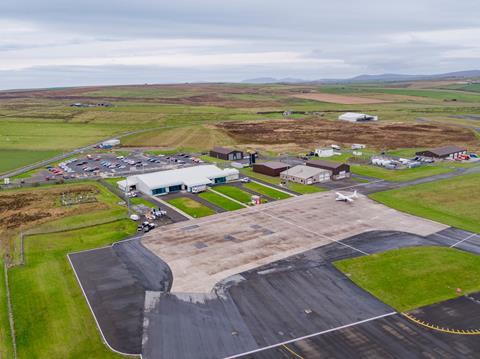In Scotland’s remote Orkney Archipelago, the coastal hub of Kirkwall is renowned for its long links to the past.
The biggest town in the region’s 70-plus islands is almost 1,000 years old, and the gateway to seven UNESCO-listed neolithic ruins dating back around 5,000 years.

But Kirkwall is also evolving as a centre for the future.
Its airport hosts the UK’s first low-carbon aero research precinct, the Sustainable Aviation Test Environment (SATE), established in 2020 to help develop and evaluate zero-emission technologies and future concepts for regional aircraft.
As a remote location critically reliant on short-range flights, there’s probably no more apt base for such a programme than the heart of the Orkneys. Nor was there a better time to rethink the future than during the pandemic.
“This region is an ideal ‘living laboratory’ for testing aviation and aerospace technology,” says Jayne Golding, SATE Manager for HITRANS, the Inverness-based Highlands and Islands Transport Partnership, which coordinates the programme funded as part of the UK Government’s Future Flight Challenge.
“SATE offers the opportunity to test and demonstrate programmes with meaningful social and economic benefits, then deploy them,” explains Golding. “Kirkwall Airport is well suited as a test environment location due to the variety of short routes it offers as a hub connecting Orkney’s island communities.”
Commuter flights from Kirkwall to neighbouring islands can be as brief as nine minutes, which is all it routinely takes for the 15nm (27km) connection to the isle of Stronsay.
The Orkneys also host the world’s shortest scheduled air route, a piffling 1.5nm hop between the isles of Westray and Papa Westray, which takes about 2min. Boarding and deplaning take longer.
This is textbook territory for short-range electric or hybrid-electric aircraft, many of which do not need major airport facilities or re-energising at their destinations.
In addition to Kirkwall, test flights have operated to or from seven other airports as part of the SATE programme, which is targeting as many as 17 airfields, many now used for general aviation.
SATE’s core participants are Highlands and Islands Airports Limited (HIAL), which operates 11 airports including Kirkwall, the European Marine Energy Centre (EMEC), an expert in wave and tidal energy and a green hydrogen producer, and multiple existing and emerging aircraft operators and manufacturers.
Low-cost autonomous drone manufacturer Windracers has partnered with Royal Mail to test pilotless cargo flights from Kirkwall, and in 2021, in amidst the global Covid meltdown, enabled communities on the isle of North Ronaldsay to receive next-day deliveries for the first time. This year, hub-and-spoke networks will be developed with other partners for autonomous cargo flights across the islands.
UK regional carrier Loganair is working with Cranfield Aerospace Solutions to inaugurate zero-emission flights in the Orkneys by 2027, using Britten-Norman BN2 Islander commuter planes converted to hydrogen-electric propulsion.
US-based battery-electric pioneer Ampaire has demonstrated its Electric Eel aircraft between Kirkwall, where it was charged, and neighbouring Wick Airport, where ARC Aerosystems has conducted tethered flight tests of its C600 eVTOL freight drone.
Studies by Hybrid Air Vehicles have concluded that its giant Airlander airships – from 2028 to be offered in a hybrid-electric configuration – could easily serve airports, small airfields and even sheltered bodies of water in SATE territory.
And HIAL is exploring an ‘airspace test environment’ for further trials of uncrewed, zero-emission freight flights.
“SATE has demonstrated the capability of new technology and the social and economic benefits that can be derived to the communities in Northern Scotland,” says Golding.
“It has created a sense of expectation and anticipation that this technology will come to market in the near future.”
But before then, there’s a bigger challenge for SATE – ensuring its own sustainability.
In March next year, its current round of funding will end. New backing is now being explored to retain key partnerships as technologies tested in the Orkneys approach commercialisation – modern history of which Kirkwall and SATE want to be a part.





















![[Photo] Korean Air K-UAM](https://d3lcr32v2pp4l1.cloudfront.net/Pictures/100x67/7/3/1/101731_photokoreanairkuam_478072.jpg)




